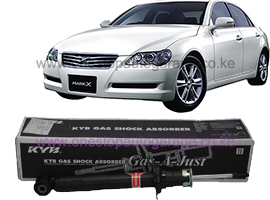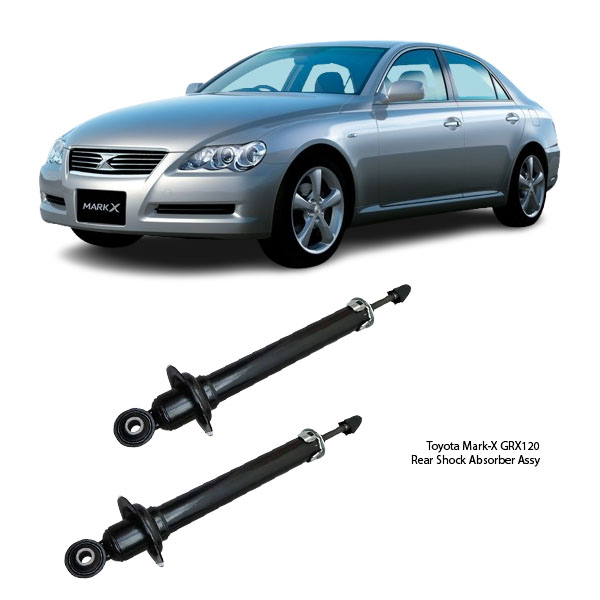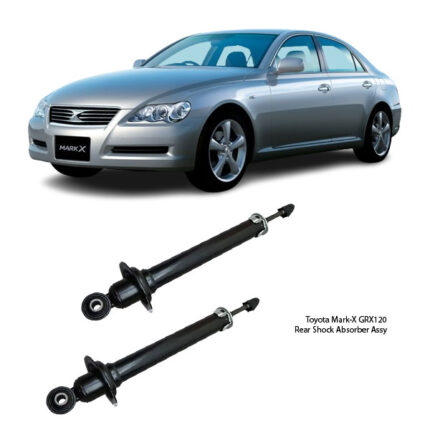Get Toyota Mark-X GRX120 Rear Shock Absorber Assy 551120 in Kenya
The Rear Shock Absorber Assembly is a critical component of a vehicle’s suspension system. It plays an essential role in maintaining ride comfort, vehicle control, and overall safety. Despite not being as immediately visible or glamorous as other car parts, shock absorbers are indispensable when it comes to ensuring a smooth, stable, and predictable driving experience, especially on uneven or rough roads.
In simple terms, a rear shock absorber helps manage the up-and-down movement of the rear wheels by controlling the suspension’s rebound and compression. Without it, a vehicle would bounce uncontrollably, reducing grip, comfort, and driver control.
What is a Rear Shock Absorber Assembly?
The Rear Shock Absorber Assembly refers to the complete unit installed in the rear section of a vehicle’s suspension system. It generally includes:
-
Shock Absorber (Damper): The core hydraulic or gas-filled cylinder that dampens movement.
-
Mounting Bushes and Bolts: Components that secure the shock to the suspension and chassis.
-
Dust Cover or Boot: A sleeve that protects the piston rod from dirt and debris.
-
Bump Stop (Optional): Prevents the shock from bottoming out during heavy compression.
While some vehicles use a separate coil spring and shock, others use a coilover design, where the spring and shock are integrated. The design depends on vehicle type, weight distribution, and intended use.
How Rear Shock Absorbers Work
Shock absorbers do not support vehicle weight—that’s the job of springs. Instead, they control the motion of the springs. When the rear wheel hits a bump, the spring compresses, absorbing the impact. The shock absorber resists this motion and then helps bring the spring back to its original position in a controlled manner.
Internally, most shock absorbers work by forcing hydraulic oil through tiny valves inside the shock cylinder. The resistance to this flow slows down the piston movement, which in turn dampens the spring’s motion. In gas-charged shocks, pressurized nitrogen gas helps minimize aeration (foaming), improving performance and consistency.
Functions of the Rear Shock Absorber Assembly
-
Ride Comfort: Absorbs and dissipates road impacts to prevent the vehicle from bouncing or jarring the occupants.
-
Vehicle Control: Maintains contact between the tires and road surface for maximum traction and control.
-
Load Stability: Helps distribute weight evenly, especially when the rear is carrying passengers or cargo.
-
Braking Support: Reduces body squat and helps keep the rear end from lifting during braking.
-
Cornering Stability: Minimizes body roll and sway during turns and lane changes.
Advantages of a Good Rear Shock Absorber Assembly
-
Enhanced Driving Comfort: Smooths out bumps, potholes, and road vibrations.
-
Better Road Holding: Keeps tires in contact with the road, especially on uneven surfaces.
-
Improved Safety: Increases braking efficiency and reduces risk of skidding or fishtailing.
-
Reduced Wear on Other Components: Prevents excessive stress on tires, bushings, and suspension arms.
-
Longer Vehicle Lifespan: By controlling harsh impacts, the shock absorber helps maintain the integrity of the chassis and suspension system.
-
More Predictable Handling: Ensures the vehicle responds consistently to steering and road conditions.
Disadvantages of a Faulty or Worn-Out Rear Shock Absorber
-
Bumpy Ride: The vehicle feels harsh over uneven roads, with noticeable bouncing.
-
Reduced Stability: Difficulty maintaining control, especially when turning or braking.
-
Increased Braking Distance: Worn shocks don’t keep the wheels grounded, affecting stopping performance.
-
Uneven Tire Wear: Excessive bouncing causes inconsistent tire contact and premature tread wear.
-
Noisy Operation: A worn shock may produce clunking, knocking, or squeaking sounds.
-
Rear-End Sagging or Swerving: The back of the vehicle may dip or sway excessively when accelerating, braking, or cornering.
Common Signs of a Failing Rear Shock Absorber
-
Excessive Bouncing: After hitting a bump, the vehicle continues to bounce several times.
-
Leaking Fluid: Visible oil leakage down the shock body indicates internal seal failure.
-
Noisy Suspension: Clunking or rattling noises from the rear may indicate worn-out mounts or internal damage.
-
Nose Diving or Rear Squatting: The car dips or squats excessively during braking or acceleration.
-
Poor Handling: Increased body roll, fishtailing, or unpredictable cornering.
-
Tire Cupping: Uneven tire wear caused by inadequate damping of vertical tire movement.
Types of Rear Shock Absorbers
-
Twin-Tube Shock Absorbers:
-
Economical and common in standard passenger vehicles.
-
Consist of an inner and outer tube with hydraulic fluid.
-
Offer good comfort but less suited for high-performance or heavy-duty use.
-
-
Mono-Tube Shock Absorbers:
-
Feature a single cylinder with high-pressure gas and oil separated by a floating piston.
-
Offer improved heat dissipation, better response, and are often used in performance and off-road applications.
-
-
Coilover Shock Absorbers:
-
Combine a spring and shock absorber in one unit.
-
Allow adjustable ride height and damping in performance applications.
-
-
Load-Leveling or Air Shocks:
-
Use air pressure or hydraulic fluid to automatically adjust ride height based on load.
-
Ideal for vehicles that carry heavy loads or tow frequently.
-
When Should You Replace Rear Shock Absorbers?
Shock absorbers typically last between 60,000 to 100,000 kilometers, depending on driving conditions and vehicle use. However, early failure can occur due to:
-
Frequent off-road or rough terrain driving
-
Overloading the vehicle
-
Exposure to road salt or corrosion
-
Driving with damaged springs or suspension parts
It is recommended to inspect the shocks at every major service and replace them in pairs (both rear shocks) to maintain balanced performance.
How to Replace a Rear Shock Absorber Assembly
Tools Required:
-
Jack and jack stands
-
Wrench or socket set
-
Penetrating oil (for rusted bolts)
-
Torque wrench
-
New shock absorber assembly
Steps:
-
Lift the Vehicle: Safely jack up the rear of the vehicle and secure with stands.
-
Locate the Rear Shocks: Find the shock absorbers mounted vertically between the axle and the chassis.
-
Remove the Old Shock: Unbolt the lower and upper mounts. It may require effort if rusted.
-
Install New Shock: Position the new shock and secure it with bolts, tightening to manufacturer-specified torque.
-
Repeat on the Other Side: Always replace both shocks together for even damping.
-
Test Drive: Check for improved stability, reduced noise, and overall ride quality.
Maintenance Tips
-
Visual Checks: Regularly inspect for leaks or damage to the shock body and bushings.
-
Check After Load Changes: If you’ve recently added heavy cargo or towing equipment, shocks may need upgrading.
-
Wash Off Salt/Mud: Keep the shock absorbers clean to prevent corrosion.
-
Listen and Feel: Pay attention to ride quality and unusual noises as early indicators of failure.
Follow us on Facebook for more parts.




